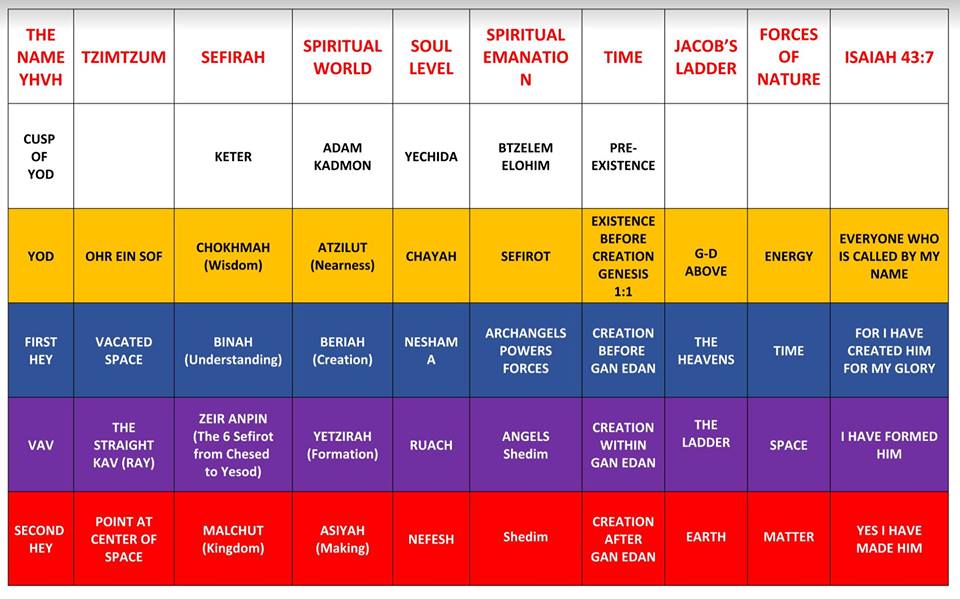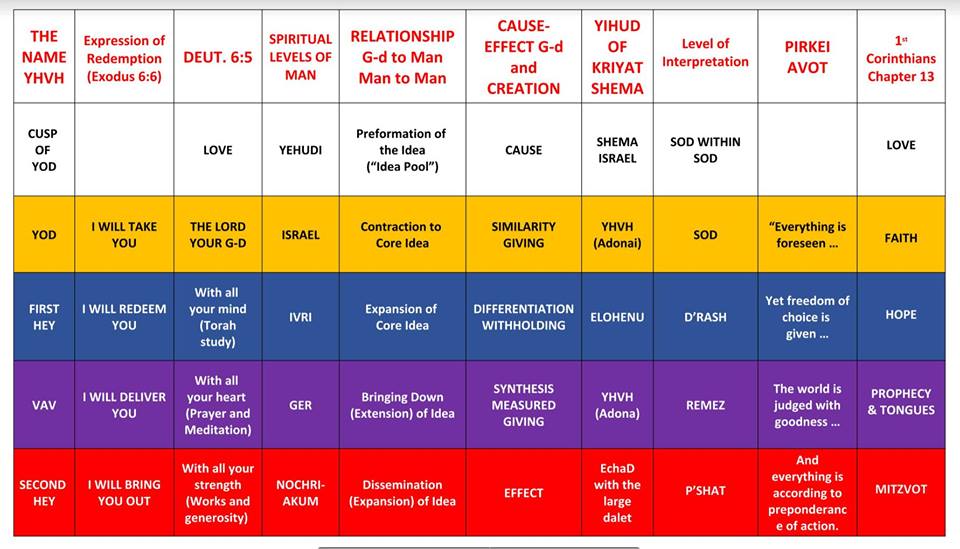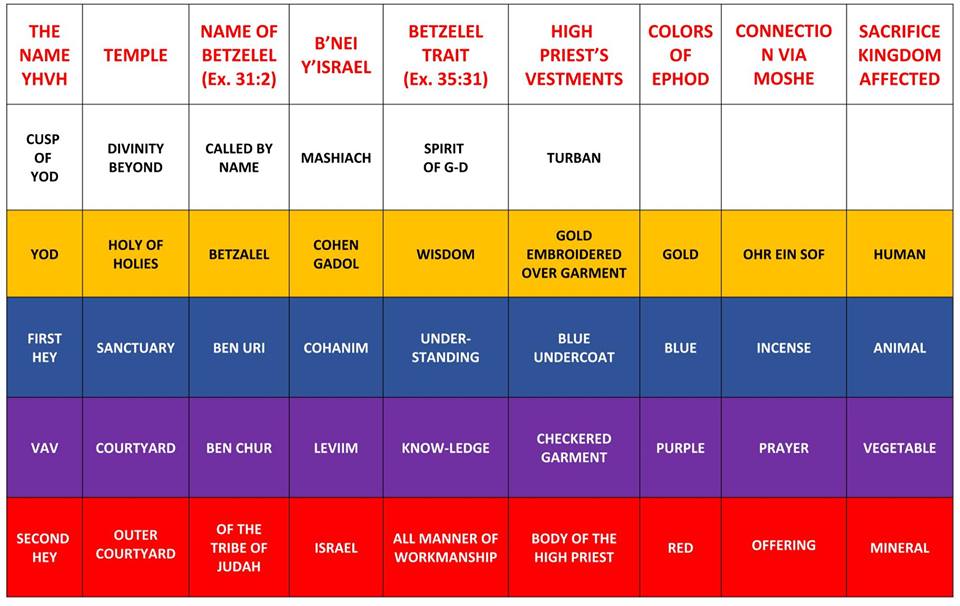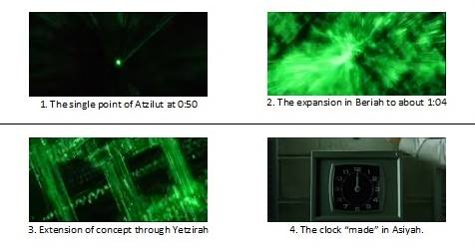Last updated: 3.19.18 @ 7:00pm EST
Summation:
These are notes from week 1 of a 10-week study begun March 17, 2018. This week we focused on the idea of Torah ‘templates’ that give us a visual that can help with understanding concepts. These templates are based on the 4-letter name of G-d (Yud-Hey-Vav-Hey.) This also includes the hidden “cusp” of the letter Yud, thus giving a fifth level.
The 5th level often relates to the ‘essence’ of the things below it, and permeates each. Not all templates include a 5th level. Both the 4th and 5th levels are considered ‘infinite.’ There are no aspects of physical space here of course. The 4th level is considered, “beyond creation (the bottom 3 levels) but within existence,” whereas the 5th level is “beyond existence.”
The vertical content of each column may relate to concepts or entities or functions. Sometimes the divisions are qualitative, or they can be a progression from top-down or bottom-up, or something else entirely. By comparing things within each chart and between charts, we can start to make deeper connections in our understanding of Torah.
The tentative schedule for the next 9 weeks follows:
- March 24 – Overview of Sefirot. Focus on Keter, Chochmah, Binah and Da’at
- March 31 – Omer Study: CHESED: “The Seven Ushpizin”
- April 7 – Omer Study: GEVURAH: “7 Habits of Highly Effective People” (Stephen Covey book)
- April 14 – Omer Study: TIFERET: “Ana Bekoach” prayer
- April 21 – Omer Study: NETZACH: Characters from Winnie the Pooh, The Matrix, Harry Potter, etc.
- April 28 – Omer Study: HOD: The Psychology of Building Resilience
- May 5 – Omer Study: YESOD: The Middot and The Tzaddik
- May 12 – Omer Study: MALCHUT: Concepts from “Sha’are Orah” (Gates of Light)
- May 19 – TBD (Shavuot chat, parsha study with Bamidbar – who knows!)
Below are 3 charts we used for the discussion. Each one includes a number of concepts associated with the theme of the chart, as they relate to the 5 levels. These concepts all come from traditional Jewish sources other than one place which is noted. There is a master chart with over 100 levels at www.13petals.org/soulchart, Below these charts and is more information related to the Four Worlds of Existence.
These chart themes in order are:
- Aspects of Creation
- Spiritual Concepts (assorted)
- The tabernacle/temple, priesthood and offerings
Note that each chart has the same first column, which is the 4-letter Name with the additional cusp level.
Chart 1: Aspects of Creation

- Column 1: The YHVH Name and cusp of the Yud. There are ‘names’ of G-d found in the text of the Tenach such as Ehyeh, Elohim, El, Yah. Shaddai, El Chain, Adonai. There is also a concept of “names’ related to a certain ‘number of letters’ which is conceptual and found in Torah literature, i.e. the 12-letter name, 22-letter, 42-letter, 72-letter. These are not ‘spelled out’ names of course. The name YHVH is unique as it is both possible to pronounce (though this is traditionally not done at this time) as well as representing a concept of 4/5 levels of relationship as seen in these charts.
- Column 2: Tzimtzum is the concept of ‘restriction’ or ‘contraction.’ Tzimtum ‘works both ways,’ regarding processes from the top-down or bottom-up. The term is most often used with regard to restricting or ‘blocking out’ superfluous things that are in the way of us better connecting to G-d. This can be something orchestrated by G-d in our lives (i.e., challenging circumstances) or done by ourselves (i.e., deep prayer, fasting). Here however, we are referring to a unique Tzimtzum where G-d had to “constrict of G-d” in order for some ‘thing’ to exist other than ‘only G-d.’ These teachings are primarily in the works of the Arizal. The basic concept here is the singular “light of G-d” (Ohr Ein Sof) which is at the level of the Yud. It is the origin of ‘Creation’ which follows. First was created a Chalal, a vacated space, at the level of the first Hey. The straight ray (kav), the level of the vav) penetrated the void to the center (level of the final Hey) from where Creation emanates (See Adam Kadmon). It is critical to avoid any literal, spatial, or geometric understandings of the Vacated Space and the Kav. As complex as this sounds it is quite logical. If the ‘infinite G-d’ was all there was, where can creation ‘exist?’ There is ‘no place’ that is not solely “G-d,” so something has to change. The process of tzimtzum explains this. Examining this, sets the stage for further columns as the Ohr Ein Sof is very ‘singular’ (like the small Yud) and remains ‘infinite’ and ‘outside’ of Creation at the level of the Yud. The vacated space is something ‘new’ and ‘expansive.’ (within the upper spiritual world) reflecting the very shape of the letter Hey. The ray like the letter Vav, is a ‘connecting’ aspect. Last is the second Hey, which relates to a second expansion (within our physical world.)
- Column 3: Each level is associated with an ’emanation’ or ‘characteristic’ of G-d that we can relate to from our perspective. These are called the Sefirot, and there are ten grouped as shown in the chart. The six making up “Zeir Anpin” (lesser countenance) reflect the idea of a group – in this case, acting in ways such as; a multifaceted, mitigating filter from the perspective of “softening judgment,’ from above, or our own attributes (made in the Image of G-d) that we work on to improve “tikkun middot”). This idea of six plus one after will appear in several places, including of course the six days of creation, followed by the 7th day of rest.
- Column 4: The process of creations involves several “spiritual worlds,” three of which are part of creation and two preceding it. At the top level of the hidden cusp is “Adam Kadmom” (primordial man) the highest world of utmost unity and potential. This world is considered ‘beyond existence’ and our ability to grasp. The persona of Adam Kadmon is what was projected into the vacated space of the Chalal mentioned above. The next world (and the first world within ‘existence’) is that of Atzilut, from the word ‘aitzel’ meaning to ‘be near’ (i.e., to G-d). This is the level where the Sefirot, ‘hidden in Adam Kadmon’ are ‘definable’ for us. This world is also considered ‘beyond creation’ and ‘infinite.’ This then brings us to the three worlds within Creation, which are Beriah (creation), Yetzirah (formation) and Asiyah (making). The aspects of each of these are discussed elsewhere.
- Column 5: Corresponding to the previous, are ‘five levels of the soul.’ Here too, we find two levels ‘beyond creation’ (and accessibility for most people) and three that are attainable. Beginning at the bottom is the ‘basic’ level of the soul, the Nefesh which functions in all human beings. The next level of the soul, Ruach is where a person starts to contemplate spiritual matters. Sometimes they give up, sometimes the stagnate at this level. Other times they divert into non-Torah spiritual areas. For those who do reach a connection to the G-d of Israel, they attain the level of the Neshama. The higher level of Chaya relates to a connection between the souls of Israel, something a true tzaddik has. The highest level of Yechidah is ‘union with G-d,’ and applies to something like a ‘messianic’ figure or a martyr.
- Column 6: Spiritual Emanations. At the top/hidden level is the “Image of G-d” (B’tzelem Elohim) we are made in (akin to Adam Kadmon). Following this is the level of the Sefirot, which exist through all levels below. This level is within ‘existence’ but beyond creation. Next we enter the three levels of Creation again, the first relating to the ‘heaven;y realm of the Throne of G-d, heavenly Temple, etc.) which is the world of powers (Paul) or forces (Ramchal) that govern creation. The next level is that of angels which are malachim/messengers that function between the heavenly world and our physical world. (See Jacob’s ladder below.) The concept of sheddim/demons are entities that are “part physical and part spiritual” (Derech Hashem) thus they traverse the two lower worlds (as our dreams do).
- Column 7: The concepts of existence and time are connected and seen in the early chapters of Genesis. The term “Elohim” at the beginning of Gen. 1:1. relates to existence just prior to Creation. We then see the 3 worlds of Creation as they relate to prior, during and after Adam is in Gan Edan. Adam remains a singular entity pre-Eden, though all the emanations of G-d exist within him. Chava (Eve) is “formed” in the world of Yetzirah/Formation. When they exit Eden they enter a primary level of physical existence in Asiyah.
- Column 8: Jacob’s ‘ladder’ (Sulam Yaacov) dream in Genesis is a great visual of the 4 worlds within existence as shown. Note the role of angels going ‘to and from’ in the world of Yetzirah between the upper and lower worlds. (Angels=Malakim=messengers)
- Column 9: The Forces of nature correspond to thing such as the idea of Divine Energy before Creation (Ohr Ein Sof). The idea of ‘time’ that begins with Creation. Space which requires the six aspects of up-down, left-right and front-back. And matter which relates to the physical world within Asiyah. (Note that Asiyah is a spiritual world which the physical word resides in.)
- Column 10: This verse from Isaiah directly mentions several of the worlds by name and alludes to the process of creation.
Chart 2: Spiritual Concepts

- Column 1: The 4-letter Name and cusp of the Yud.
- Column 2: The expressions of redemption begin from the bottom: 1.) Removal of physical suffering (Asiyah). Deliverance from the emotional connections to slavery (Yetzirah). Redemption into the holy level of Neshama (Beriah). Taking them as His own ‘one’ people. (Atzilut).
- Column 3: The command to love G-d from Deuteronomy 6:5, with the three ‘ways’ relating to our intellectual, emotional and physical aspects of self.
- Column 4: The spiritual levels of man from the bottom up: The idolator. The Ger who is ‘on the path.’ The Hebrew (Ivri) who crosses over to connect with G-d. “Israel” part of the collective and now on a path of attaining devekut (clinging) and Yehudi reflecting unity with G-d at the highest level.
- Column 5: How G-d relates to us or how we do to each other via the process of an ‘idea,’ from its ‘pre-existence’ (the cusp) to the first spark in our minds, (the Yud) the initial expansion of ideas, (the first Hey) bringing it down into reality, (the Vav) then putting it into action (the second Hey and expansion).
- Column 6: The cause exists in the will of G-d. At the pro-active side of Chokhmah is the compulsion to give. Binah, on the left, then judges and places a restriction. Things then return to the center where the six Sefirot work to ‘synthesize’ the proper amount. Finally, the ‘effect’ is felt in the world of Asiyah.
- Column 7: The Shema is a prayer of unification of worlds. G-d is “one.” The echad in the text of a Torah scroll has a large Dalet at the end of the word “Echad,” which represents the ‘four corners of the earth’ that the Shekinah (which is at this level) reaches out to. (Dalet is the 4th letter in the Alef-Bet.) There is a tradition to pronounce the final ‘d-sound’ firmly as a reminder.
- Column 8: The basic levels of text interpretation. The 5th level (Sod within the Sod) is that which Mashiach will teach us. (Explaining the ‘spaces between the words,’ etc.) This is also the level of Chassidus, which explains the Sod of Kabbalah and brings it “down to earth,” to the level of Asiyah.
- Column 9: Pirkei Avot presents a thought that proceeds through the four worlds reflecting aspects of what is foreseen before creation in Atzilut, the concept of ‘freedom’ in Binah/Beriah, judgment of Zeir Anpin and action in Asiyah.
- Column 10: This is the only non-traditional example on the charts but rests solidly in kosher Torah. 1st Corinthians remarkably follows the pattern, mentioning several concepts that align accordingly. Love, at the level of Keter/Adam Kadmon is expressed in terms of bittul, self-nullification, (as taught in Chassidus) which relates back to the mitzvoth carried out at the level of Malchut/Asiyah. “Prophecy and tongues” (At the level of Yetzirah) are said to vanish one day, which is consistent with the concept of this world disappearing when the heavenly and earthly temples come together. There will be not more need for an in-between world of messengers/angels, thus the “vav” in ‘YHVH’ vanishes, and the name becomes “YHYH.”
Chart 3: Temple/Tabernacle Related

- Column 1: The 4-letter Name and cusp of the Yud.
- Column 2: The temple setup is a key template. (See diagram in bottom section.) The outer court was open to all, much as the Nefesh is common to all humanity. The inner court was open to Israelites, (even those struggling in faith – the soul level of Ruach) but there were various restrictions. The sanctuary was reserved for the priests. This relates to the level of Beriah, the heavenly Throne Room. The connection between all the people and G-d was the Cohen Gadol, who functioned in the Holy of Holies at the level of Atzilut – which is ‘nearness’ to G-d.
- Column 3: Betzalel’s name, as described in that verse, has associations with each level. The gematria of ‘Betzalel,” is 153 and is associated with messianic concepts. (i.e., John 21:11) Other traditional ideas associated with Betzalel are explained in the book, “Divine Design” by Rabbi Moshe Shlomo Emanuel. You can purchase this here: https://www.amazon.com/Divine-Design-Rabbi-Shlomo-Emanuel/dp/1568713959.
- Column 4: The corresponding spiritual levels of “Israel” regarding the Temple. (This is similar to the levels required to climb the mountain in Exodus 24.)
- Column 5: The traits of Betzalel as they relate to each world. (See above book link)
- Column 6: The high priest’s vestments. Interesting here is the checkered garment which corresponds to the ‘mixed world’ of Yetzirah.
- Column 7: The colors of the ephod. (This is the basis for the color scheme of all the charts.) Red is the earth. Purple the ‘mixture’ of red and blue. (This equates to the “mixed world” of Yetzirah.) Blue reflects the spiritual heavens/shamayim (Beriah).
- Column 8: Connection made to G-d via Moshe’s instruction or involvement with aspects of the Mishkan service.
- Column 9: The sacrifices included and impacted; the altar made of the mineral world, the wood to burn the fire, the animal sacrificed; and the human bringing the sacrifice.
The following contains supplemental slides and tables from other Torah studies we’ve had on Facebook.
Another idea concerns four Torah concepts and how they relate to our ‘mission on earth.’ Hashgaha Pratit is the singular Will of G-d at the level of Atzilut/Chokhmah/Chaya. Teshuvah is ‘return’ and is that just ‘touching’ our world drawing us back, the level of Beriah/Binah/Neshama. The idea of repairing our six emotive attributes (as Malchut is passive) follows at the level of Yetzirah/Zeir Anpin/Ruach. Restriction comes in the form of challenges which enable us to see beyond the physical aspects of Asiyah/Malchut/Nefesh.

The path of Teshuva crosses worlds and involves several concepts:

The aspects of Sukkot evolve around the three worlds of creation and corresponding levels of the soul.
- The Etrog = Asiyah/Malchut (the bride)
- The Lulav (which has 6 green objects) = Yetzirah/Zeir Anpin (the groom)
- The semi-open roof of the Sukkah = Beriah/Binah to where we ascend and ‘look back down from heaven’

The 10 Sefirot fall along the 4 Worlds and have connections to many other aspects of Torah:

The 5 Worlds and Neo’s Path from The Matrix
The character of Neo from the Matrix movie and his path to “The Source” as related to the 5 worlds and characteristics of Betzalel. Note this is presented in order of ‘attainment’ from top down.
| World | Bezalel | Associated Concept within Neo | Level of Soul |
| Asiyah | All manner of workmanship | Neo’s skills he learns prior to being extricated from the Matrix | Nefesh |
| Yetzirah | Knowledge | The rules of the Matrix that he learns primarily from Morpheus, and subsequent decision he must make to continue on the path of the one |
Ruach |
| Beriah | Understanding | The guidance he receives from the Oracle (Binah/Imma) | Neshama |
| Atzilut | Wisdom | The insight he received from the Architect (Chokhmah/Abba) | Chaya |
| Adam Kadmon | Spirit of God | His unification with the Computers to save Zion by making all One. | Yechida |
The Process of Redemption in Exodus and Neo from The Matrix
| World | Redemptive Process in Exodus | Associated Concept within Neo |
| Asiyah | He made them “free” through His revelation. (Though they had the choice to accept or reject what Moshe had to tell them.) They stopped serving Egypt even though they physically remained a bit longer in the land |
Neo is given the message of truth (while in the confining non-reality of the Matrix), remains a while longer, and is offered the choice with the red pill and blue pill. |
| Yetzirah | He physically took them out of Egypt, a false reality where they were “bound” and unable to serve G-d. (Egypt = “Mitzrayim” = confined place) |
He is removed, through no power of his own, from the Matrix – his own “Mitzrayim” where he was a slave. |
| Beriah | He redeemed them by taking them through the waters and delivering the final crushing blow to the Egyptians when the waters annihilated them (thus giving them great confidence). He also put them through many tests and trials along the path (i,e., at Marah in Exodus 15:22-27). |
Neo learns to replace the error and fear of his previous ways, receiving instruction in truth, being granted teachers along his path and a number of tests to pass |
| Atzilut | He took them as His people to the promised land where they would be free to serve Him through His Torah and repair all of Creation. |
He becomes the “One” – returning to “The Source” and maximizing his potential which reaches through all the Worlds – even back to anyone held within the densest klippot of the Matrix. |
The 4 Worlds as Shown in the Opening Scene to Matrix Reloaded
From the beginning of the second movie, Matrix Reloaded.
CLICK TO VIEW: https://www.youtube.com/watch?v=-1KXoXtACUk&feature=related
- At the 45 second mark begins movement toward the singular point of Atzilut which appears at the 50-second mark
- From about 51 seconds to about the 1:04 mark is the first expansion in Beriah
- From 1:04 to about 1:22 is the ‘formation’ and descent through Yetzirah
- At 1:22 or so is the final “made” product in Asiyah

